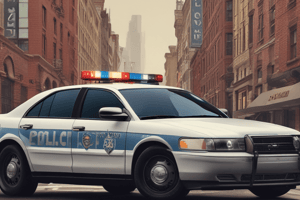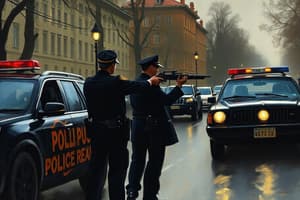Podcast
Questions and Answers
What is required by NRS §29-211 for each law enforcement agency in Nebraska regarding vehicle pursuits?
What is required by NRS §29-211 for each law enforcement agency in Nebraska regarding vehicle pursuits?
- Agencies must implement a written pursuit policy and enforce it without review.
- Agencies must adopt and implement a written policy regarding the pursuit of motor vehicles. (correct)
- Agencies must train personnel only when a new policy is adopted.
- Agencies need to have a verbal agreement on pursuit policies among officers.
Which of the following is NOT included in the annual documented analysis required by the Department?
Which of the following is NOT included in the annual documented analysis required by the Department?
- An analysis of the ‘Police Vehicle Pursuits’ policy.
- A review of Police Vehicle Pursuits reporting procedures.
- An assessment of police officers' performance during pursuits. (correct)
- A review of all documented incidents involving vehicle pursuits.
What training does NRS §29-211 require for law enforcement officers commencing employment?
What training does NRS §29-211 require for law enforcement officers commencing employment?
- Pursuit driving at the Nebraska Law Enforcement Training Center or an equivalent program. (correct)
- Basic driving skills without a focus on pursuits.
- Only in-service training with no formalized program.
- Training focused on vehicle maintenance and safe driving.
What does the system of mandatory continued planning and review entail according to NRS §29-211?
What does the system of mandatory continued planning and review entail according to NRS §29-211?
How must sworn personnel acknowledge their understanding of the pursuit policy?
How must sworn personnel acknowledge their understanding of the pursuit policy?
What is the purpose of reviewing pursuit records annually?
What is the purpose of reviewing pursuit records annually?
What kind of training documentation is required during initial training on vehicle pursuits?
What kind of training documentation is required during initial training on vehicle pursuits?
Which authority is responsible for ensuring the training of law enforcement officers under NRS §29-211?
Which authority is responsible for ensuring the training of law enforcement officers under NRS §29-211?
Under what circumstances is physical cruiser contact authorized?
Under what circumstances is physical cruiser contact authorized?
What technique should officers not use during cruiser contact?
What technique should officers not use during cruiser contact?
In which situation is physical cruiser contact allowed as a last resort?
In which situation is physical cruiser contact allowed as a last resort?
What must officers complete if property damage occurs during cruiser contact?
What must officers complete if property damage occurs during cruiser contact?
What precaution must officers take when considering physical cruiser contact?
What precaution must officers take when considering physical cruiser contact?
How should cruisers behave during a pursuit without command authorization?
How should cruisers behave during a pursuit without command authorization?
What report is required if cruiser contact results in damage to non-OPD vehicles?
What report is required if cruiser contact results in damage to non-OPD vehicles?
What is the primary consideration when deciding to use physical cruiser contact?
What is the primary consideration when deciding to use physical cruiser contact?
What details are required when documenting the first observation of a suspect vehicle during a pursuit?
What details are required when documenting the first observation of a suspect vehicle during a pursuit?
Which circumstances would necessitate a follow-up investigation after a pursuit?
Which circumstances would necessitate a follow-up investigation after a pursuit?
What must the authorizing supervisor do after a pursuit has been conducted?
What must the authorizing supervisor do after a pursuit has been conducted?
What types of conditions must be noted during a pursuit's documentation?
What types of conditions must be noted during a pursuit's documentation?
What is the primary purpose of reviewing pursuits internally?
What is the primary purpose of reviewing pursuits internally?
Which item is NOT a required element to describe during the pursuit documentation?
Which item is NOT a required element to describe during the pursuit documentation?
What document must the supervisor complete and forward after reviewing the pursuit?
What document must the supervisor complete and forward after reviewing the pursuit?
What can result from a pursuit if the suspect eludes capture?
What can result from a pursuit if the suspect eludes capture?
What is defined as a statutory pursuit under Nebraska Revised Statute (NRS) §13-911?
What is defined as a statutory pursuit under Nebraska Revised Statute (NRS) §13-911?
What defines a secondary unit in a vehicle pursuit situation?
What defines a secondary unit in a vehicle pursuit situation?
Which of the following correctly describes a slick top vehicle?
Which of the following correctly describes a slick top vehicle?
What must happen during pursuit termination by OPD officers?
What must happen during pursuit termination by OPD officers?
What is the primary responsibility of the supervisor in vehicle pursuits?
What is the primary responsibility of the supervisor in vehicle pursuits?
Which statement is NOT true concerning a traffic stop?
Which statement is NOT true concerning a traffic stop?
What is true about an unmarked vehicle in the context of policing?
What is true about an unmarked vehicle in the context of policing?
What aspect does NOT directly relate to the responsibilities during vehicle pursuits?
What aspect does NOT directly relate to the responsibilities during vehicle pursuits?
What should a supervisor immediately do after taking command of a pursuit?
What should a supervisor immediately do after taking command of a pursuit?
In evaluating whether to terminate a pursuit, what must a supervisor consider?
In evaluating whether to terminate a pursuit, what must a supervisor consider?
What must officers do if they exceed the speed limit while attempting to stop a vehicle?
What must officers do if they exceed the speed limit while attempting to stop a vehicle?
What happens if the area/crew supervisor does not respond during a pursuit scenario?
What happens if the area/crew supervisor does not respond during a pursuit scenario?
Once a supervisor has taken command of a pursuit, who retains the authority to determine if it continues or is terminated?
Once a supervisor has taken command of a pursuit, who retains the authority to determine if it continues or is terminated?
Which of the following is NOT a requirement specified for vehicle pursuits?
Which of the following is NOT a requirement specified for vehicle pursuits?
What must the supervisor do after evaluating a pursuit?
What must the supervisor do after evaluating a pursuit?
What does violating traffic laws while pursuing a suspect require from officers?
What does violating traffic laws while pursuing a suspect require from officers?
What action should the helicopter crew take when they are ready to engage in a pursuit?
What action should the helicopter crew take when they are ready to engage in a pursuit?
In a violent felony situation, how should the pursuing vehicles follow the fleeing vehicle?
In a violent felony situation, how should the pursuing vehicles follow the fleeing vehicle?
What must ground units do when the helicopter crew announces they have the vehicle under surveillance in a misdemeanor situation?
What must ground units do when the helicopter crew announces they have the vehicle under surveillance in a misdemeanor situation?
Under what circumstances will the helicopter crew spotlight the fleeing vehicle?
Under what circumstances will the helicopter crew spotlight the fleeing vehicle?
Which of the following statements accurately reflects the helicopter's role during a violent felony situation?
Which of the following statements accurately reflects the helicopter's role during a violent felony situation?
What is required from ground units when they receive further instructions from the helicopter crew?
What is required from ground units when they receive further instructions from the helicopter crew?
How many pursuing vehicles are recommended to follow in a verified violent felony situation?
How many pursuing vehicles are recommended to follow in a verified violent felony situation?
What should the helicopter crew do when the vehicle they are monitoring comes to a stop?
What should the helicopter crew do when the vehicle they are monitoring comes to a stop?
Flashcards
Slick Top Vehicle
Slick Top Vehicle
A marked Omaha Police Department (OPD) vehicle that doesn't have exterior roof-mounted emergency lights. They have lights on the front grill and a siren.
Secondary Unit
Secondary Unit
Any OPD unit that joins a pursuit to assist the primary unit. They follow at a safe distance.
Traffic Stop
Traffic Stop
When a police officer directs a vehicle to pull over to investigate a possible traffic violation.
Unmarked Vehicle
Unmarked Vehicle
Signup and view all the flashcards
Pursuit Termination
Pursuit Termination
Signup and view all the flashcards
Vehicle Pursuit
Vehicle Pursuit
Signup and view all the flashcards
Supervisor Responsibility
Supervisor Responsibility
Signup and view all the flashcards
Command Oversight
Command Oversight
Signup and view all the flashcards
Pursuit Intervention Technique (PIT)
Pursuit Intervention Technique (PIT)
Signup and view all the flashcards
Physical cruiser contact
Physical cruiser contact
Signup and view all the flashcards
When is physical cruiser contact allowed?
When is physical cruiser contact allowed?
Signup and view all the flashcards
Boxing in, heading off, or driving alongside
Boxing in, heading off, or driving alongside
Signup and view all the flashcards
Reporting requirements for forcible stop using physical cruiser contact
Reporting requirements for forcible stop using physical cruiser contact
Signup and view all the flashcards
Motor Vehicle Accident report
Motor Vehicle Accident report
Signup and view all the flashcards
Roadblocks and tire deflation devices
Roadblocks and tire deflation devices
Signup and view all the flashcards
Airbags and cruiser contact
Airbags and cruiser contact
Signup and view all the flashcards
Supervisor's Role in Pursuit
Supervisor's Role in Pursuit
Signup and view all the flashcards
Supervisor Unreachable
Supervisor Unreachable
Signup and view all the flashcards
Supervisor Taking Command
Supervisor Taking Command
Signup and view all the flashcards
Supervisor's Evaluation
Supervisor's Evaluation
Signup and view all the flashcards
Supervisor's Ultimate Decision
Supervisor's Ultimate Decision
Signup and view all the flashcards
Emergency Lights and Siren
Emergency Lights and Siren
Signup and view all the flashcards
Safety of Others
Safety of Others
Signup and view all the flashcards
Pacing or Overtaking
Pacing or Overtaking
Signup and view all the flashcards
Pursuit Initiation Report
Pursuit Initiation Report
Signup and view all the flashcards
Primary Officer
Primary Officer
Signup and view all the flashcards
Ground Command Supervisor
Ground Command Supervisor
Signup and view all the flashcards
Pursuit Review
Pursuit Review
Signup and view all the flashcards
Pursuit Recording Form
Pursuit Recording Form
Signup and view all the flashcards
Pursuit Review Committee
Pursuit Review Committee
Signup and view all the flashcards
Pursuit Termination Report
Pursuit Termination Report
Signup and view all the flashcards
Annual Pursuit Report
Annual Pursuit Report
Signup and view all the flashcards
NRS §29-211 (2)
NRS §29-211 (2)
Signup and view all the flashcards
Mandatory Police Pursuit Policy Review
Mandatory Police Pursuit Policy Review
Signup and view all the flashcards
NRS §29-211
NRS §29-211
Signup and view all the flashcards
Annual Pursuit Review
Annual Pursuit Review
Signup and view all the flashcards
Chief's Approval of Annual Pursuit Report
Chief's Approval of Annual Pursuit Report
Signup and view all the flashcards
Police Vehicle Pursuit Policy
Police Vehicle Pursuit Policy
Signup and view all the flashcards
Pursuit Policy Training for Recruits
Pursuit Policy Training for Recruits
Signup and view all the flashcards
Helicopter's Initial Role in Pursuit
Helicopter's Initial Role in Pursuit
Signup and view all the flashcards
Helicopter Taking Command
Helicopter Taking Command
Signup and view all the flashcards
Pursuit Tactics for Violent Felony
Pursuit Tactics for Violent Felony
Signup and view all the flashcards
Helicopter's Ongoing Role in Violent Felony
Helicopter's Ongoing Role in Violent Felony
Signup and view all the flashcards
Pursuit Termination for Non-Violent Crimes
Pursuit Termination for Non-Violent Crimes
Signup and view all the flashcards
Ground Unit Confirmation in Non-Violent Crimes
Ground Unit Confirmation in Non-Violent Crimes
Signup and view all the flashcards
Helicopter Spotlight Usage
Helicopter Spotlight Usage
Signup and view all the flashcards
Pursuit Decision Matrix
Pursuit Decision Matrix
Signup and view all the flashcards
Study Notes
Police Vehicle Pursuits Policy
- Policy aims to narrowly regulate pursuits, prioritizing public safety and departmental liability.
- Vehicle pursuits are inherently dangerous for officers, suspects, and the public.
- Omaha Police Department (OPD) vehicles with emergency equipment are authorized for pursuits.
Definitions
- Authorized Emergency Vehicle: OPD vehicle with operable emergency equipment (as defined by statute).
- Due Regard: Standard of care expected of a reasonable person under similar circumstances.
- Marked Police Vehicle: OPD vehicles with emergency lights (360° visibility) and sirens.
- Overtake: Effort to close distance with a target vehicle for a traffic stop (excluding attempts to stop or apprehend).
- Pace: Matching target vehicle speed without overtaking, to determine speed (no stop attempts).
- Parallel: Driving OPD vehicle parallel to a street with a pursuit on that street.
- Police Motorcycle: OPD motorcycle with lights and siren (no 360° visibility).
- Primary Unit: Initiates the pursuit or assumes control.
- Pursuit Termination: Discontinuing pursuit and deactivating emergency equipment.
- Secondary Unit: Backup unit following primary unit at a safe distance
- Slick Top Vehicle: OPD cruiser without roof-mounted emergency lights (lights on front grill).
Supervisor Responsibility
- Command oversight is crucial for pursuit safety.
- Area/crew supervisor is primarily responsible for pursuit decisions (or 911 dispatcher if supervisor unavailable).
- Supervisor immediately notifies 911 dispatch of pursuit command assumption.
- Supervisor evaluates whether to continue or terminate pursuit.
Vehicle Pursuit Requirements
- Officers must consider all relevant factors and drive with due regard.
- Pursuits exceeding speed limits or violating traffic laws require emergency lights and sirens.
- No more than two OPD vehicles involved in a direct pursuit unless another officer directly commands more.
- Officers will not engage in pursuit while driving unmarked vehicles without emergency lighting.
Objective Risk Factors
- Low Risk: Straight roads, few intersections, few pedestrians, good weather, speeds under posted limit, helicopter available.
- Moderate Risk: Some intersections, light pedestrian traffic, speeds above posted limit by a moderate amount, hazardous, non-extreme maneuvers.
- High Risk: Frequent intersections, bad weather, poor visibility, blind curves, heavy traffic, high speeds above posted limit.
Pursuit Decision Matrix
- Matrix assists officers in determining pursuit appropriateness based on risk factors.
Radio Communication
- Secondary unit takes over radio communications unless necessary, with appropriate cross-unit notification.
- Pursuits in Omaha use specified radio channels.
Forcible Stop of a Fleeing Vehicle
- Use of force—physical cruiser contact—allowed in extreme situations (after command authorization & risk assessment).
- Officers must proceed with caution and adhere to policy in making physical contact.
- Necessary reports, including incident reports, are required.
Deployment Requirements
- Vehicle contact only allowed with command authorization or if mandated under exigent circumstances.
- Use of PIT maneuvers disallowed.
Pursuits into Iowa
- Misdemeanant pursuits across state lines into Iowa prohibited under existing laws.
- Felony pursuits into Iowa handled according to extradition processes.
Reporting Requirements
- Officers involved in pursuits must complete required reports (OPD Form 214)
- Supervisor reviews pursuit details and submits required reports.
- Complete, detailed written reports are required.
- Data like date, time, location, officer names, vehicle numbers, and the nature of the pursuit must be recorded.
Follow-Up
- Further investigation by the Traffic Unit follows pursuits, where deemed appropriate.
- Vehicle impounding is conducted as necessary.
Review of Pursuits
- Ground supervisors review completed actions on pursuits prior to completing reports.
- Review includes radio recordings, videos, cruiser videos.
- Detailed review of all aspects of the pursuit.
Mandatory Review
- Training bulletins, General orders, and in-service training are made available to all personnel on the policy.
- All information is documented annually.
Recruit Training
- OPD recruits receive initial training on the policy.
- Training is documented.
References and Accreditation
- Relevant court cases, statutes, previous OPD orders, and accreditation standards are referenced.
Studying That Suits You
Use AI to generate personalized quizzes and flashcards to suit your learning preferences.





